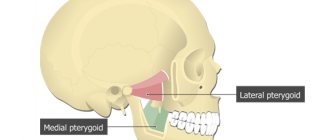Pain after caries treatment: normal or pathological?
Pain after treatment and filling does not always indicate pathology. In 70% of cases, it is the norm, especially if you come to the doctor with advanced, deep caries, progressing or developing into pulpitis.
Mild pain traditionally occurs due to mechanical irritation of the treated tooth - biting on it, chewing hard food, pressing with a finger or a toothpick. This is due to the close fit of the bottom of the carious cavity to the pulp and nerve of the tooth. When you press on the coronal part, the filling puts even more intense pressure on the pulp, which provokes pain. Normally, they are not too pronounced and rather resemble a dull “bone” pain.
There is no need to worry about such pain - over time, your health will definitely return to normal, and the tooth will stop bothering you even with pressure or irritation. Neutralization of uncomfortable sensations is associated with the production of a protective layer of dentin by the pulp, which, as it were, “distances” it from the base of the filling. This process may take up to 2 months.
The first cause for concern is the manifestation of nagging or acute but constant pain, which does not depend on external factors.
Toothache cannot be tolerated. “Muffling” it with strong analgesics is also not recommended, especially if the nature of the symptom is unknown to you.
Leave your phone number. The clinic administrator will call you back.
By leaving a request on the site, you consent to the processing of personal data
Make an appointment
Initial consultation with a dentist
For free!
After filling the cervical part of the tooth (the one located at the junction with the gum), a transient increase in sensitivity is likely. Your tooth can react to cold and hot, as well as sweet and sour. Pay attention to the presence of a “step” or depression between the base of the filling and the original tooth tissue. If you notice an unevenness on the surface, contact your dentist immediately, as this may subsequently lead to inflammation or exposure of the root.
Another variant of the norm may be pain that occurs against the background of:
- Individual response to treatment of dental caries (especially drilling, grinding and polishing);
- X-raying the tooth with special equipment;
- Irritation of soft tissues due to the need to drill out a deep cavity (usually with pulpitis).
Discomfortable sensations go away on their own after 1-8 weeks, depending on the original problem and the individual characteristics of the body.
Dental treatment is painful. We destroy myths.
Since childhood, dental treatment has been associated with pain. And even at a more mature age, the thought will certainly itch in the background: what if it hurts? Or will the anesthesia not work?
Pavel Anatolyevich Pazhlakov, a dentist at the Dudko and Sons Dental Implant Center,
answered questions about the possibilities of pain relief in modern dentistry - Pavel Anatolyevich, could you outline what options for pain relief exist in modern dentistry? All methods are divided into local, general anesthesia and their combinations. Local means that it acts only on the area that actually needs to be anesthetized, that is, in our case, on the nerves that directly transmit the pain signal from the tooth. With general anesthesia (or anesthesia), a person falls asleep and does not feel anything. In dentistry, this option is in the vast majority of cases redundant. We always try to adhere to the golden rule: pain relief must be adequate and reasonable - that is, correspond to the specific clinical situation. In each case, you need to choose the most effective and, at the same time, safe method of pain relief. — How can you “turn off” the nerve that transmits the pain signal from the tooth?
For this purpose, local anesthetics are used, what is popularly called “freezing”. These substances block the transmission of signals along the nerve. How to deliver the anesthetic to the nerve? The two most popular options are the so-called infiltration and conduction anesthesia. In the first case, we simply inject the anesthetic into the tissue using a syringe - naturally, it reaches the peripheral nerve endings and blocks them. In the second, we inject the drug in the immediate vicinity of the nerve in the place where all the fibers conducting the signal from the desired area have already gathered into a single bundle. In any case, all the paths through which a message about pain can reach the brain are blocked - and the person does not feel anything. - But the injection itself is not very pleasant either. Some people are afraid of the injections themselves. For this case, there is topical anesthesia. Its essence is that an anesthetic, gel or spray, is applied to the area that needs to be numbed before anesthesia is administered with a syringe. Application anesthesia is not very effective in the sense that it only anesthetizes the superficial layers. But it allows you to “turn off” an area of skin so that the patient does not feel the injection. — Do local anesthesia have side effects? Some people are intolerant to local anesthetics. You may remember that when you go to the dentist, he always asks: “Have you had pain relief before?” This is done to see if the person has had a reaction to the local anesthesia. — If there was such a reaction, what to do? Treat teeth under anesthesia?
No, why so radical right away? Just use a different anesthetic; there are a lot of them available now. Sometimes, however, there are patients who cannot tolerate any local anesthetics at all - then yes, anesthesia or sedation. — It turns out that any patient can be given adequate pain relief? And is there a difference in pain relief for the upper and lower jaws? Yes. There are, of course, difficult cases, but the arsenal of methods is so wide that there is always something suitable. And if we consider the analgesic effect, then a 100% anesthetic effect is not always observed on the lower jaw because bone tissue is more dense. Because of this, it is less permeable to the anesthetic solution. In such cases, we increase the waiting time for the onset of anesthetic pain relief or increase the dose of the drug. - Thank you, Pavel Anatolyevich, after talking with you, it’s almost no longer scary to go to get your teeth treated. But I still really don’t want them to be drilled... And don’t! My advice to patients is to contact dentists before anything starts to hurt. You should try to go for a preventive examination at least twice a year in order to prevent complications that can cause a lot of problems. There is no need to be afraid to go to the dentist, he is not an inquisitor: if you are healthy, no one will try to make extra “holes” in your teeth. And if your teeth need to be treated, today it can be done absolutely painlessly. In order to visit a dentist , you need to: make an appointment by calling +375445450910 or go to the consultation page.
Fear of dentists - first person:
The article was prepared by a specialist: Pavel Anatolyevich Pazhlakov
When is there a reason to worry?
Sometimes doctors recommend that their patients take painkillers after treatment, as they objectively assess the complexity and assume temporary side effects. But symptom relief does not take longer than 3-4 days even after tooth extraction. You must understand that pain is not an enemy at all, but a benefit that signals a problem. And if it appears on an ongoing basis for a week or more, this is a good reason to visit a specialist.
Pay close attention to any accompanying symptoms:
- Fever or slight but constant increase in temperature;
- Bleeding gums around the treated tooth;
- Acute attacks that occur at night;
- A significant increase in sensitivity, encouraging you to completely abandon potential irritants in the form of ice cream or hot tea;
- Numbness of the soft tissues of the jaw at the site of the procedures;
- Darkening or blueness of the gums;
- General malaise and weakness without objective reasons.
Constant aching pain with periodic exacerbations can be associated with overdrying or underdrying of the formed cavity before filling. Both mistakes by the doctor are fraught with complications. When overdrying, persistent irritation of nerve endings can occur, leading to death. If it is not dried enough, the adhesive (sticky material) cannot be absorbed into the dentin, and when the filling shrinks, it comes off from the bottom of the cavity, creating a discharged space here like a vacuum. This also irritates the nerve endings (in professional language the phenomenon is called “debonding”).
In both cases, there is no point in enduring pain for more than a week. Perhaps after 7 days it will really stop bothering you, and the reason for going to the dentist will disappear by itself. But if a week after treatment has passed and the symptom persists, you should immediately visit a doctor.
How to relieve toothache yourself?
- If pain occurs, the right solution would be to take special painkillers. Dentists advise their patients Nurofen, Ketanov, Dexalgin, Baralgin. You can also take regular analgin in tablets. Specialists at Dr. Granov's clinic strongly recommend that you stop taking aspirin and medications containing high concentrations of acetylsalicylic acid. The analgesic effect from them is small, but in high dosages the substance provokes complications, sometimes very dangerous for general health.
- Temporarily stop chewing food on the affected side. Perhaps the symptom is associated specifically with biting - that is, mechanical irritation.
- Under no circumstances use “grandmother’s methods” in the form of heating, lotions or compresses. The procedure can significantly aggravate the current situation and even obviously complicate the process of subsequent treatment, if necessary.
- Antibiotics should not be taken without a doctor's prescription. The selection of antibacterial drugs is a responsible step in which the doctor carefully weighs the benefits and risks. Unauthorized use of antibiotics can lead to unpredictable consequences.
- You can purchase a natural product at the pharmacy - dental drops. It contains plant extracts of valerian, mint and camphor. Soak a tight cotton swab in the solution and apply it to the sore tooth. Change the tampon every 10 minutes until pain subsides.
- You can help yourself by rinsing with decoctions of soothing herbs: mint, lemon balm, chamomile.
In what cases is it important to visit a doctor?
Visit a specialist urgently if you have:
- Acute toothache;
- Pain combined with bleeding gums;
- Dull pain that sharply worsens when eating cold or hot food (this may indicate untreated chronic pulpitis);
- The temperature has risen;
- Discharge from the gums or changes in the gum tissue are observed.
If you don't trust the dentist who treated your tooth before symptoms began, find a better professional. The specialists at Dr. Granov’s clinic are ready to help you with dental treatment and correct the mistakes of others.
We are responsible for the health of our patients and choose progressive, safe, effective treatment methods.
Will root canal treatment hurt?
Indeed, root canal treatment has a bad reputation as being very painful - but we assure you, this reputation is completely undeserved. Those complaints and unpleasant memories that many of those who have undergone root canal treatment will willingly share with you are associated not with the procedure itself, but with the period of unexpected pain and other unpleasant sensations preceding it, which, in the end, led your interlocutor to dentist chair. In most cases, root canal treatment is a completely painless procedure. This is what we solemnly promise you. If you still don't really believe it... You might be surprised - but in some cases, root canal treatment is painless, perhaps even without anesthesia. Why? Yes, because the nerve tissue in the tooth simply dies completely, and the dead nerve tissue cannot transmit pain sensations. Does this mean that root canal treatment of any tooth can be performed without the use of anesthesia? No, that doesn't mean; but if you are still anxiously expecting pain during root canal treatment, we assure you that you are mistaken. Will the dentist numb your tooth before starting root canal treatment? Yes, it will definitely happen. No one enjoys painful sensations—neither you nor your dentist. Therefore, in order for the treatment procedure to go well, without complications and unpleasant surprises, most dentists perform mandatory preliminary anesthesia of all teeth on which canal treatment is planned. Remember: your doctor's job is to ensure that the results of his treatment last you, if possible, for a lifetime. Therefore, he needs to concentrate on his work - and your painful reaction is unlikely to allow him to do this. Pain relief will help both you and your doctor feel more confident and calm. Canal treatment is a useful thing! There are many reasons to see your dentist for a root canal. If your tooth starts to hurt and your gums are swollen, root canal treatment will be the first of those procedures that will help you get rid of pain and swelling. In some cases, already at the very beginning of treatment, you may suddenly feel that the pain has completely gone away. And even in cases where there was no pain or swelling, but there are indications, treatment of the canal will not be superfluous. It’s just that in the absence of painful symptoms, it will be much easier and more effective. You will feel confident and calm, the results of treatment will be more predictable. And, besides, the sooner you start canal treatment, the more opportunities you will have to get rid of unpleasant complications in the future, such as painful inflammation of the tooth (acute abscess).











